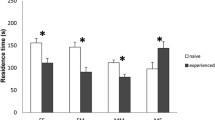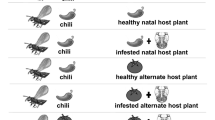Abstract
Choosing suitable hosts is an important component of parasitoid fitness. Many parasitoids reject already-parasitized hosts. In some species, females reject hosts in which they had recently oviposited, but accept these hosts minutes or hours later. Parasitoids were suggested to mark hosts with repellent pheromones at oviposition and to accept them again after the mark fades. We tested a complementary hypothesis, stating that parasitoids’ host acceptance thresholds decrease with time since their previous oviposition because of a change in internal state, independent of the hosts’ deterrent marking. We scored the acceptance of hosts (eggs of the moth Phthorimaea operculella, Gelechiidae) by Copidosoma koehleri (Encyrtidae) parasitoids in single-choice experiments. Acceptance of self-parasitized (low-quality) hosts increased with time since the wasps’ previous host encounter. The wasps accepted two non-parasitized (high-quality) hosts within a 5-s presentation interval, indicating that they are physiologically able to oviposit twice in quick succession. Parasitized hosts, presented after varying time intervals to conspecifics with uniform host encounter experience, were accepted at similar frequencies. However, as predicted by the working hypothesis, increasing the time elapsed since the wasps’ last oviposition significantly enhanced the acceptance rates of hosts that had been parasitized by conspecifics 2 min earlier. Learning of host-associated cues during oviposition may enable wasps to identify and reject parasitized hosts, while fading of this association from their short-term memory during periods with no host encounters could trigger acceptance of parasitized hosts. State-dependent host acceptance may adaptively allow wasps to avoid self-superparasitism and to adjust conspecific superparasitism rates to foraging conditions.

Similar content being viewed by others
References
Ardeh MJ, de Jong PW, van Lenteren JC (2005) Intra- and interspecific host discrimination in arrhenotokous and thelytokous Eretmocerus spp. Biol Control 33:74–80
Babendreier D, Hoffmeister TS (2002) Superparasitism in the solitary ectoparasitoid Aptesis nigrocincta: the influence of egg load and host encounter rate. Entomol Exp Appl 105:63–69
Bügler M, Rempoulakis P, Shacham R, Keasar T, Thuijsman F (2013) Sex allocation in a polyembryonic parasitoid with female soldiers: an evolutionary simulation and an experimental test. PLoS One 8(6):e64780
Chow FJ, Mackauer M (1986) Host discrimination and larval competition in the aphid parasite Ephedrus californicus. Entomol Exp Appl 41:243–254
Colinet H, Salin C, Boivin G, Hance TH (2005) Host age and fitness-related traits in a koinobiont aphid parasitoid. Ecol Entomol 30:473–479
Dorn S, Beckage NE (2007) Superparasitism in gregarious hymenopteran parasitoids: ecological, behavioural and physiological perspectives. Physiol Entomol 32:199–211
Doutt RL (1947) Polyembryony in Copidosoma koehleri Blanchard. Am Nat 81:435–453
Feldhaar H (2011) Bacterial symbionts as mediators of ecologically important traits of insect hosts. Ecol Entomol 36:533–543
Godfray HCJ (1994). Parasitoids: behavioral and evolutionary ecology. Princeton University Press
Hardy IC, Blackburn TM (1991) Brood guarding in a bethylid wasp. Ecol Entomol 16:55–62
Hubbard SF, Harvey IF, Fletcher JP (1999) Avoidance of superparasitism: a matter of learning? Anim Behav 57:1193–1197
Islam KS, Copland MJW (2000) Influence of egg load and oviposition time interval on the host discrimination and offspring survival of Anagyrus pseudococci (Hymenoptera: Encyrtidae), a solitary endoparasitoid of citrus mealybug, Planococcus citri (Hemiptera: Pseudococcidae). Bull Entomol Res 90:69–75
Keasar T, Segoli M, Barak R, Steinberg S, Giron D, Strand MR, Bouskila A, Harari AR (2006) Costs and consequences of superparasitism in the polyembryonic parasitoid Copidosoma koehleri. Ecol Entomol 31:277–283
Keinan Y, Kishinevsky M, Segoli M, Keasar T (2012) Repeated probing of hosts: an important component of superparasitism. Behav Ecol 23:1263–1268
Lampert EC, Bowers MD (2010) Host plant species affects the quality of the generalist Trichoplusia ni as a host for the polyembryonic parasitoid Copidosoma floridanum. Entomol Exp Appl 134:287–295
Lebreton S, Christidès JP, Bagnères AG, Chevrier C, Darrouzet E (2010) Modifications of the chemical profile of hosts after parasitism allow parasitoid females to assess the time elapsed since the first attack. J Chem Ecol 36:513–521
Liu S, Zhao B, Bonjour E (2012) Host marking and host discrimination in phytophagous insects. In: Liu T, Kang L (eds) Recent advances in entomological research. Springer, Heidelberg, Dordrecht, London, New York, pp 73–85
McKay T, Broce AB (2004) Discrimination of self-parasitized hosts by the pupal parasitoid Muscidifurax zaraptor (Hymenoptera: Pteromalidae). Ann Entomol Soc Am 97:592–599
Mehrnejad MR, Copland MJW (2007) Host discrimination by the endoparasitoid Psyllaephagus pistaciae (Hymenoptera: Encyrtidae): a case of time-dependent ability. Biocontrol Sci Tech 17:401–411
Nufio CR, Papaj DR (2001) Host marking behavior in phytophagous insects and parasitoids. Entomol Exp Appl 99:273–293
Ode PJ, Heinz KM (2002) Host-size-dependent sex ratio theory and improving mass-reared parasitoid sex ratios. Biol Control 24:31–41
Outreman Y, Le Ralec A, Plantegenest M, Chaubet B, Pierre JS (2001) Superparasitism limitation in an aphid parasitoid: cornicle secretion avoidance and host discrimination ability. J Insect Physiol 47:339–348
Roitberg BD, Prokopy RJ (1983) Host deprivation influence on response of Rhagoletis pomonella to its oviposition deterring pheromone. Physiol Entomol 8:69–72
Rosi MC, Isidoro N, Colazza S, Bin F (2001) Source of the host marking pheromone in the egg parasitoid Trissolcus basalis (Hymenoptera: Scelionidae). J Insect Physiol 47:989–995
Ruther J (2013) Novel insights into pheromone-mediated communication in parasitic hymenopterans. Chemical ecology of insect parasitoids. Wiley, Chichester, pp 112–144
Santolamazza-Carbone S, Rodrıguez-Illamola A, Cordero Rivera A (2004) Host finding and host discrimination ability in Anaphes nitens Girault, an egg parasitoid of the Eucalyptus snout-beetle Gonipterus scutellatus Gyllenhal. Biol Control 29:24–33
Segoli M, Bouskila A, Harari A, Keasar T (2009) Brood size in a polyembryonic parasitoid wasp is affected by the relatedness among competing larvae. Behav Ecol 20:761–767
Segoli M, Keasar T, Bouskila A, Harari AR (2010) Host choice decisions in the polyembryonic wasp Copidosoma koehleri (Hymenoptera: Encyrtidae). Physiol Entomol 35:40–45
Sirot E, Ploye H, Bernstein C (1997) State dependent superparasitism in a solitary parasitoid: egg load and survival. Behav Ecol 8:226–232
Stelinski LL, Oakleaf R, Rodriguez-Saona C (2007) Oviposition-deterring pheromone deposited on blueberry fruit by the parasitic wasp, Diachasma alloeum. Behaviour 144:429–446
Strand MR, Obrycki JJ (1996) Host specificity of insect parasitoids and predators. Bioscience 46:422–429
Ueno T, Tanaka T (1996) Self–host discrimination by a parasitic wasp: the role of short-term memory. Anim Behav 52:875–883
van Alphen JJ, Visser ME (1990) Superparasitism as an adaptive strategy for insect parasitoids. Ann Rev Entomol 35:59–79
van Baaren J, Boivin G (1998) Learning affects host discrimination behavior in a parasitoid wasp. Behav Ecol Sociobiol 42:9–16
van Baaren J, Boivin G, Nénon JP (1994) Intra-and interspecific host discrimination in two closely related egg parasitoids. Oecologia 100:325–330
Wang XY, Yang ZQ, Wu H, Gould JR (2008) Effects of host size on the sex ratio, clutch size, and size of adult Spathius agrili, an ectoparasitoid of emerald ash borer. Biol Control 44:7–12
Acknowledgments
The study was supported by the Israel Science Foundation (http://www.isf.org.il/), grant number 414/10. We thank Ronen Shapir and Nina Dinov for rearing the insects. Comments from four anonymous referees on previous versions helped to improve the paper.
Author information
Authors and Affiliations
Corresponding author
Additional information
Communicated by S. Cremer
Rights and permissions
About this article
Cite this article
Kishinevsky, M., Keasar, T. State-dependent host acceptance in the parasitoid Copidosoma koehleri: the effect of intervals between host encounters. Behav Ecol Sociobiol 69, 543–549 (2015). https://doi.org/10.1007/s00265-014-1865-x
Received:
Revised:
Accepted:
Published:
Issue Date:
DOI: https://doi.org/10.1007/s00265-014-1865-x




